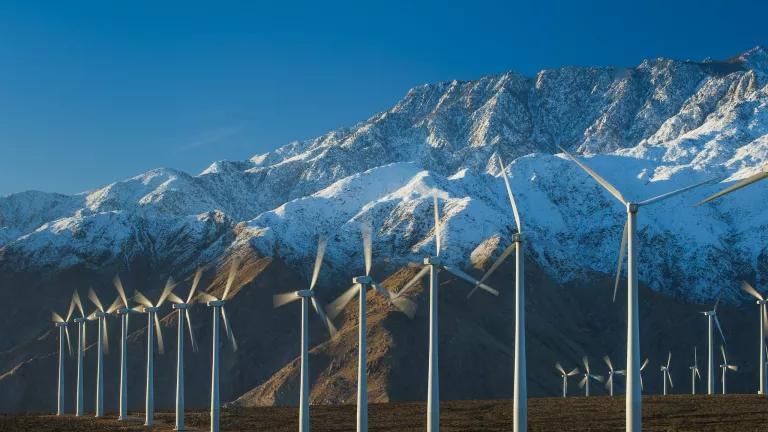
Technological innovations that reduce noise during offshore wind construction also have the potential to generate domestic jobs.
To avoid the worst impacts of climate change, we need to scale up and quickly grow all forms of clean energy in the U.S., including offshore wind power. Thankfully, the Biden-Harris administration and individual states are setting ambitious renewable energy targets, and offshore wind is now rapidly advancing in all regions.
But offshore wind, like all forms of energy development, has impacts on its surrounding environment, and it is critically important that we develop this new technology in a responsible manner, where potential impacts are avoided, reduced, mitigated, and monitored.
Pile driving offshore wind turbine foundations into the seabed during construction generates underwater noise pollution, a primary environmental concern. Pile-driving noise is extremely loud and has the potential to harm marine life, from the largest whales to the smallest zooplankton, as well as interfere with their ability to feed and communicate, or drive them from preferred habitats.
Marine species are already having difficulty coping with other human-caused stressors, including myriad sources of underwater noise pollution and climate change, so it is vital we reduce any additional potential impacts from offshore wind development as much as possible.

Fortunately, there are technological innovations that significantly reduce the noise generated by pile-driving or allow pile-driving to be avoided altogether. Many of the companies developing these technologies are based right here in the U.S., bringing further gains to the adoption of environmental solutions. Benefits include the potential to create U.S.-based jobs and to establish the U.S. as a global leader on environmentally responsible offshore wind development.
Two technologies are great examples:
- Noise attenuation technology: For turbines that will be pile-driven, it’s important to set up a shield around the foundation to attenuate the noise as quickly as possible. For example, AdBm is a noise abatement system developed by an American-owned company based in Austin, Texas. This technology provides targeted noise reduction in lower frequency bands in which many marine animals, including large whales and fish, are known to be the most sensitive. When paired with a far-field noise attenuation technology like a bubble curtain, which reduces noise at higher frequencies, this home-grown system can impressively achieve about 25 decibels in noise attenuation.
- Gravity-based foundations: Turbine foundations that do not need to be hammered into the seabed by pile-driving drastically reduce underwater noise pollution during offshore wind construction. Gravity-based foundations—large concrete blocks that rest on top of the seabed—can be used for wind turbines and substations. Because the concrete components are difficult to transport, they must be fabricated locally.

To make these technologies truly a win-win for wildlife and the economy, we need greater leadership from the administration and from states. The proposal by Equinor to include gravity-based foundations in its project design envelope for the Empire Wind Project, which will supply energy to New York state, is an exciting development and indicates the adoption of quiet foundations is feasible in the U.S. It is our hope that the company will make the right decision for marine life and choose gravity-based foundations.
But we need to do more. Ambitious noise reduction targets should be required of developers to incentivize them to invest in the most effective noise attenuation technologies and quiet foundation types. By contrast, the first full-scale offshore wind project to get the green light for construction, Vineyard Wind, was only required to reduce noise by six decibels in its final federal permits. (It should be noted that the company, with urging and support from NRDC and others, has committed to a 12-decibel reduction). Pile driving is expected to emit noise on the order of approximately 220 decibels.
A six-decibel noise reduction is far below what’s possible and optimal for marine life. Much stricter standards are required in Europe, where offshore wind is booming. For example, German projects always require a near- and far-field noise mitigation solution, and stringent noise reduction measures are required by the Netherlands, Belgium, and Denmark. Other countries like the U.K., Spain, and France will soon follow suit.
We need agencies at all levels of U.S. government to require the greatest minimization of underwater noise possible throughout the project’s lifetime. Reducing the noise footprint will yield significant benefits to marine wildlife and the broader ecosystem, and prompt developers to seek out quieter development and operation options.
In addition, as many offshore wind developers are based in Europe, they often rely on existing supply chains and ship technologies to the U.S. While commitments to manufacture components domestically are growing, developers should be further incentivized to establish new supply chains in the U.S. and prioritize investment in U.S.-based companies. Ironically, the top U.S.-based noise attenuation company has contracts from Europe and Asia, but not the U.S.
These technological innovations are among the best solutions worldwide to ensure the industry moves forward in an environmentally responsible way. Capitalizing on U.S. technological leadership will help secure the offshore wind industry’s success and support the goals of the Biden-Harris administration.




